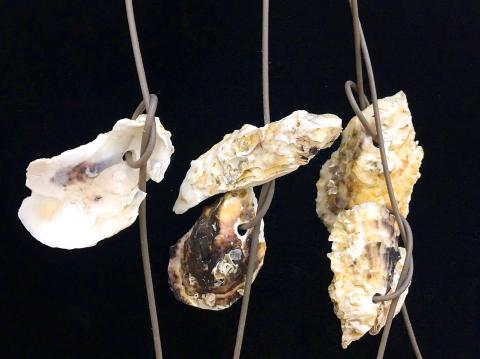A research team has discovered that a species of oyster long referred to as the “Portuguese oyster” is in fact native to Taiwan, and found that the local population has proven more robust genetically than its European counterpart.
Research conducted by the Council of Agriculture’s Fisheries Research Institute, National Taiwan Ocean University and Academia Sinica over the past four years has uncovered evidence that the Taiwanese oyster — originally thought to be a variant of the Japanese Pacific oyster — is actually the ancestor of the Portuguese oyster.
A report published in the Sept. 26 edition of Scientific Reports said Taiwanese oysters attached to the hulls of Portuguese ships docked in Taiwan in the 16th century and were carried to Europe.

Photo: Wu Hsin-tien, Taipei Times
Hsiao Sheng-tai (蕭聖代), a research assistant at the institute, said Japanese and Portuguese oysters are indistinguishable when they are young, adding that their differences can only be observed after cultivating them side by side for five years.
At maturity, the Pacific variety can grow up to 40cm in length, whereas Portuguese oysters grow to only 10cm, Hsiao said.
The Pacific oyster is found in the waters around Japan, the Korean Peninsula and northeast China, Hsiao said, adding that it is the most common artificially cultivated species worldwide.
Due to Taiwan’s proximity to Japan, researchers believe that the Taiwanese variant was at one point also part of the Pacific species, he said.
Despite this belief, doubts remained because of local fisheries experts inability to grow large oysters or breed local oysters with those imported from Japan, Hsiao said.
“We collected 313 oyster samples from the coast of Taiwan and the seas south of China, looked at the DNA and discovered that both wild and cultivated breeds from Taiwan were Portuguese oysters,” Hsiao said.
The closer to the coast oysters were caught, the closer their DNA matched that of Portuguese oysters, providing researchers the clue that led to discovering the link, Hsiao said.
A plague in 1960 nearly wiped out the Portuguese oyster in Europe, Hsiao said, adding that Japanese oysters were imported to deal with the loss, resulting in the Japanese variety being more abundant than the Portuguese variant in Europe.
“A few years ago, an infectious disease nearly wiped out the Taiwanese oyster as well, but from its survival we can infer that the local variety is more resilient, indicated the local population might be the parent species,” Hsiao said, adding that it probably gained its name after its discovery by 19th-century Portuguese researchers after being transported in the 16th century by ships sailing between Portugal and Taiwan.
The scientific name of the Pacific oyster is Crassostrea gigas, which means “large oyster,” while the Portuguese oyster is Crassostrea angulata, meaning “small oyster.”
“While ‘Portuguese oyster’ is just a colloquial name, getting people to start calling it the ‘Taiwanese oyster’ would not be easy,” Hsiao said.

Palauan President Surangel Whipps Jr arrived in Taiwan last night to kick off his first visit to the country since beginning his second term earlier this year. After arriving at Taoyuan International Airport at around 6:30 pm, Whipps and his delegation were welcomed by Minister of Foreign Affairs Lin Chia-lung (林佳龍). Speaking to gathered media, the Palauan leader said he was excited and honored to be back in Taiwan on his first state visit to Taiwan since he was sworn in this January. Among those traveling with Whipps is Minister of State Gustav N. Aitaro, Public Infrastructure

President William Lai (賴清德) yesterday thanked Palau for its continued support of Taiwan's international participation, as Taipei was once again excluded from the World Health Assembly (WHA) currently taking place in Switzerland. "Palau has never stopped voicing support for Taiwan" in the UN General Assembly, the WHO and other UN-affiliated agencies, Lai said during a bilateral meeting with visiting Palau President Surangel Whipps Jr. "We have been profoundly touched by these endorsements," Lai said, praising the Pacific island nation's firm support as "courageous." Lai's remarks came as Taiwan was excluded for the ninth consecutive year from the WHA, which is being held in

RESOLUTIONS DEBATE: Taiwan’s allies said that UN and WHA resolutions cited by China and other nations ‘do not determine Taiwan’s participation in WHO activities’ A proposal to invite Taiwan to this year’s World Health Assembly (WHA) was rejected on Monday, resulting in Taipei’s absence from the annual meeting for a ninth consecutive year, although partners spoke up for Taiwan’s participation at the first day of the meeting. The first agenda item after the opening was a “two-on-two debate” on a proposal to invite Taiwan to participate at the WHA as an observer. Similar to previous years, two countries made statements in favor of the proposal, while two others expressed their opposition. Philippine Secretary of Health Teodoro Herbosa, president of the 78th WHA, accepted the WHA General Committee’s

At least three people died and more than a dozen were injured yesterday afternoon when a vehicle struck a group of pedestrians in New Taipei City’s Sansia District (三峽). The incident happened at about 4pm when a car rammed into pedestrians at an intersection near Bei Da Elementary School. Witnesses said the sedan, being driven at a high speed, ran a red light, knocking scooters out of the way and hitting students crossing the road before careening into a median near the intersection of Guocheng and Guoguang streets. The incident resulted in three deaths and 13 injuries, including the driver, a 78-year-old man